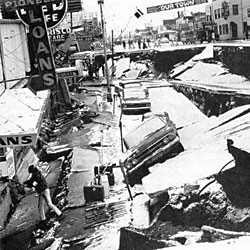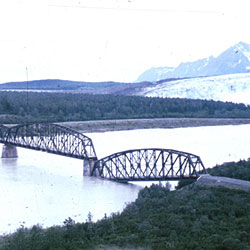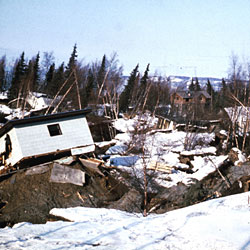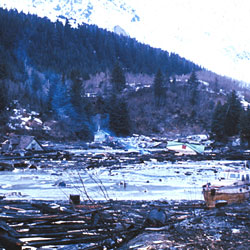- ▾ Other ShakeOuts ▾
- Alaska
- American Samoa
- Arizona
- British Columbia
- California
- Central U.S. (AL AR IA IL IN KS KY LA MO MS NE OH OK TN)
- CNMI
- Colorado
- Guam
- Hawaii
- Idaho
- Japan
- Montana
- Nevada
- New Mexico
- New Zealand
- NorthEast U.S. (CT MA ME NH NJ NY PA RI VT)
- Oregon
- Puerto Rico
- Quebec & Eastern Ontario
- SouthEast U.S. (DC DE FL GA MD NC SC VA WV)
- Texas
- Upper MidWest U.S. (MI MN ND SD WI)
- U.S. Virgin Islands
- Utah
- Washington State
- Wyoming
- Yukon
- Other Countries

Why Should You Participate?
Alaska is the most seismically active state in the U.S., home of three of the seven largest earthquakes in the 20th century, including the 9.2 magnitude 1964 Good Friday Earthquake, the second-largest ever recorded. Every Alaskan should practice to “Drop, Cover, and Hold On” since so many of us travel to areas at risk for earthquakes.
Join us for the Great Alaska ShakeOut this October.
Practice how to be safer during earthquakes with your family, your community, your school or your organization. Do a "Drop, Cover and Hold On" drill, review and update emergency preparedness plans and supplies, and act to secure your space to prevent damage and injuries.
Learn more here. Check out answers to frequently asked questions.
Benefits
Register today so that you or your organization will:
- Be counted in the largest-ever earthquake drill in Alaska!
- Be listed with other participants in your area (Optional)
- Be an example that motivates others to participate & prepare
- Be updated with ShakeOut news and preparedness tips
- Have peace of mind that you, your family, your co-workers and millions of others will be better prepared to survive and recover quickly from our next big earthquake!
EARTHQUAKE HAZARDS
Alaska has 50-100 earthquakes daily and accounts for 11% of the world’s earthquakes and over half of all earthquakes in the U.S. Alaska is situated in a unique and complex tectonic setting, in which the plates where the earth’s crust is broken into large slabs, move relative to each other. Alaska’s largest earthquakes are caused by subduction of the Pacific plate beneath Alaska as the Pacific plate moves under the North American plate between 5-7 centimeters per year. Five great underthrusting events have occurred in Alaska since 1938 despite the belief that great earthquakes are rare. These events usually occur in south-central Alaska and the Aleutian Islands.
A second type of hazard comes from the smaller magnitude 6.8 to 8.0 earthquakes, which occur in many regions of central and south-central Alaska. While smaller, these events happen more frequently and in areas that can’t always be predicted; however, magnitude 7.0 or larger earthquakes occur about every two years. A third hazard comes from the many smaller events that often occur near populated areas. While too small to cause widespread damage, they are relatively common and pose a continuous threat in urban areas.
Alaska experienced the second-largest earthquake ever recorded in 1964, a 9.2 magnitude earthquake in Prince William Sound that killed 132 people. The tsunami generated by the earthquake killed people as far south as California. The nearly five-minute earthquake and subsequent tsunami, devastated Anchorage, Chenega, Kodiak, Seward, Valdez, Whittier, and other Alaskan, Oregon, California, and British Columbia communities. The powerful earthquake produced tsunamis, liquefaction, ground fissures and failures, ground and underwater landslides that devastated communities.














Please use the following links to learn more about the earthquake hazards in Alaska:
Are you ready for the next big Earthquake (Alaska Earthquake Information Center)
Why Drop, Cover, and Hold On?
Why is it important to do a Drop, Cover, and Hold On drill? To react quickly you must practice often. You may only have seconds to protect yourself in an earthquake, before strong shaking knocks you down--or drops something on you. Practicing helps you be ready to respond.
- If you are inside a building, move no more than a few steps, then Drop, Cover and Hold On:
- DROP to the ground (before the earthquake drops you!),
- Take COVER by getting under a sturdy desk or table, and
- HOLD ON to it until the shaking stops.
- If you are outdoors when the shaking starts, you should find a clear spot away from buildings, trees, streetlights, and power lines, then Drop, Cover and Hold On. Stay there until the shaking stops.
- If you are driving, pull over to a clear location, stop and stay there with your seatbelt fastened until the shaking stops. Once the shaking stops, proceed with caution and avoid bridges or ramps that might have been damaged.
Ground shaking during an earthquake is seldom the cause of injury. Most earthquake-related injuries and deaths are caused by collapsing walls and roofs, flying glass and falling objects. It is extremely important for a person to move as little as possible to reach the place of safety he or she has identified because most injuries occur when people try to move more than a short distance during the shaking.
Look around you now, before an earthquake. Identify safe places such as under a sturdy piece of furniture or against an interior wall in your home, office or school so that when the shaking starts you can respond quickly. An immediate response to move to the safe place can save lives. And that safe place should be within a few steps to avoid injury from flying debris.
Further information:







